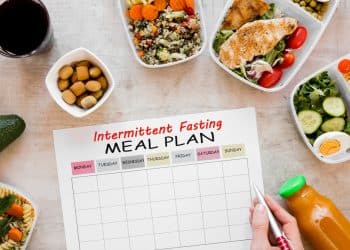Alternate day fasting (ADF) stands out among intermittent fasting (IF) protocols for its potent health benefits and flexibility. This guide explores how ADF can transform your health and fitness journey.
Alternate day fasting alternates between fasting and normal eating days, offering a simple yet effective approach to weight management and metabolic health. Its adaptability to individual lifestyles makes it an attractive option for those seeking sustainable health improvements.
Key Takeaways
- ADF cycles between fasting and normal eating days, promoting metabolic flexibility and weight loss.
- Flexibility in scheduling allows for personalized implementation, enhancing adherence and long-term success.
- On fasting days, consuming up to 500 calories strategically can optimize ketone production while mitigating discomfort.
- Proper hydration, meal planning, and mindful eating strategies are crucial for managing hunger and maintaining energy levels during fasting periods.
- ADF offers significant health benefits, including improved insulin sensitivity and cardiovascular health, beyond just weight loss.
Implementing Alternate Day Fasting: A Strategic Approach
A typical ADF schedule alternates between fasting and eating days:
- Monday: Fast
- Tuesday: Eat normally
- Wednesday: Fast
- Thursday: Eat normally
- Friday: Fast
- Saturday: Eat normally
- Sunday: Fast
This pattern extends the fasting window beyond traditional IF methods, potentially amplifying metabolic benefits. To optimize the ADF experience, consider consuming up to 500 calories on fasting days, strategically spaced to maintain ketone production while mitigating discomfort.
Optimizing Nutrition During ADF Cycles
Effective meal planning is crucial for ADF success:
Level Up Your Fitness: Join our 💪 strong community in Fitness Volt Newsletter. Get daily inspiration, expert-backed workouts, nutrition tips, the latest in strength sports, and the support you need to reach your goals. Subscribe for free!
On eating days, focus on nutrient-dense, balanced meals to support overall health and satiety. Hydration remains paramount, with unsweetened beverages like water, tea, and coffee permitted on fasting days.
Sample ADF Meal Plan for Eating Days:
- 5-8 AM: Herbal tea or black coffee
- 10 AM (breakfast): Whole grain avocado toast with a side of berries
- 2 PM (lunch): Grilled chicken salad with mixed greens and olive oil dressing
- 4 PM (snack): Greek yogurt with walnuts
- 6 PM (dinner): Baked salmon, quinoa, and roasted vegetables
- 8 PM (snack): Apple slices with almond butter
Mastering Hunger Management During ADF
Navigate fasting days with these strategies:
- Prioritize hydration to curb hunger and maintain energy levels
- Engage in light, enjoyable activities to distract from hunger sensations
- Focus on nutrient-dense foods during eating periods to support satiety
Initial challenges like hunger pangs and mental fog typically subside as your body adapts to the ADF rhythm. Persistence and a balanced approach are key to overcoming these temporary hurdles.
Advanced Strategies for ADF Success
Elevate your ADF practice with these refined techniques:
1. Cultivate Body Awareness
Develop acute sensitivity to your body’s signals, distinguishing between true hunger and habitual eating cues.
2. Strategic Meal Optimization
Design meals that maximize nutritional density and satiety, focusing on balanced macronutrients and fiber-rich foods.
3. Hydration Mastery
Implement a structured hydration plan, aiming for at least 3-4 liters of water daily, enhanced with electrolytes on fasting days.
4. Fasting Day Flexibility
Incorporate a 500-calorie allowance on fasting days to maintain metabolic flexibility while easing adaptation.
5. Goal Alignment
Regularly reassess and align your ADF practice with evolving health and fitness objectives.
6. Mindful Eating Practices
Cultivate a deeper appreciation for food through mindful eating techniques, enhancing satisfaction and nutritional intuition.
Transitioning Into and Out of Alternate Day Fasting
Implementing ADF gradually and exiting the regimen thoughtfully can optimize your fasting experience and maintain long-term health benefits.
Easing Into ADF
- Start with time-restricted feeding: Begin with a 12/12 or 16/8 intermittent fasting schedule to acclimate your body to fasting periods.
- Extend fasting windows gradually: Slowly increase your fasting duration over several weeks until you reach a full day of fasting.
- Implement a modified ADF: Initially, consume 25% of your normal caloric intake on fasting days before transitioning to full fasting or the 500-calorie approach.
- Focus on nutrient density: During eating periods, prioritize whole, nutrient-dense foods to support your body through the adaptation phase.
Exiting ADF Responsibly
- Gradual reintroduction of regular eating: Slowly decrease the number of fasting days per week over several weeks.
- Monitor portion sizes: Be mindful of portion sizes as you return to regular eating to avoid rapid weight regain.
- Maintain intermittent fasting: Consider adopting a less intensive IF schedule, such as 16/8 or 5:2, to maintain metabolic benefits.
- Continue healthy eating habits: Preserve the nutritious eating patterns developed during ADF to support long-term health.
Listen to Your Body
Throughout the transition process, pay close attention to your body’s signals. Adjust your approach if you experience persistent fatigue, mood changes, or other adverse effects. Consulting with a healthcare professional can provide personalized guidance for safe and effective transitions.
Comprehensive Health Benefits of ADF
ADF extends beyond weight management, offering a spectrum of health advantages:
1. Enhanced Insulin Sensitivity
ADF significantly improves insulin sensitivity and glucose regulation, potentially reducing type 2 diabetes risk. [1]
2. Cardiovascular Health Optimization
Regular practice can improve lipid profiles, reduce inflammation, and regulate blood pressure, contributing to overall heart health. [2]
3. Efficient Weight Management
ADF promotes sustainable weight loss through caloric restriction and metabolic adaptation. [3]
Safety Considerations and Contraindications
While generally safe, ADF may not suit everyone. Exercise caution if you:
- Have a BMI below the healthy range
- Suffer from anemia or chronic health conditions
- Have a history of eating disorders
- Are pregnant, breastfeeding, or trying to conceive
- Are under 18 or over 65 years old
- Engage in high-intensity physical activities regularly
Women may experience menstrual cycle fluctuations due to calorie restrictions. A gradual approach, starting with less intense fasting schedules, is advisable for those new to fasting.
Navigating Potential Challenges
Be aware of these common hurdles:
1. Initial Overeating Tendencies
Post-fast overeating is common initially. Practice mindful eating to calibrate portion sizes over time.
2. Maintaining Food Enjoyment
Balance health goals with the pleasure of eating. Incorporate favorite foods in moderation to sustain long-term adherence.
3. Temporary Energy Fluctuations
Expect initial dips in energy and mood. These typically resolve as your body adapts to the new eating pattern.
ADF in Context: Comparing Fasting Protocols
Understanding how ADF compares to other fasting methods can help you choose the most suitable approach:
1. ADF vs. 16/8 IF
ADF offers longer fasting periods than the daily 16-hour fast of 16/8, potentially amplifying metabolic benefits.
2. ADF vs. Warrior Diet
While both involve extended fasting, ADF allows for normal eating days, offering more flexibility than the Warrior Diet’s daily 20-hour fasts.
3. ADF vs. 5:2 Fasting
ADF provides more frequent fasting periods compared to 5:2, which may accelerate metabolic adaptations.
4. ADF vs. OMAD
ADF allows for more normal eating patterns on non-fasting days compared to the daily restriction of OMAD.
5. ADF vs. Water Fasting
ADF is more sustainable and less extreme than extended water fasts, offering similar benefits with reduced risks.
FAQs
What’s the optimal duration for an ADF regimen?
The ideal duration varies based on individual goals. After achieving initial objectives, transitioning to a less intense fasting schedule can help maintain benefits long-term.
How much weight can I expect to lose with ADF?
A 4–8% reduction in body weight over 6–8 weeks is typical, depending on individual factors and adherence.
What happens if I stop ADF?
Reverting to previous eating habits may reverse gains. Transitioning to a balanced, health-focused lifestyle is crucial for maintaining progress.
Conclusion
Alternate Day Fasting offers a powerful tool for health transformation, combining simplicity with significant metabolic benefits. Its flexibility allows for personalization, making it adaptable to various lifestyles. While challenges may arise initially, the potential for improved health outcomes makes ADF a compelling option for those seeking comprehensive wellness improvements.
Whether you’re aiming for weight management, enhanced metabolic health, or overall well-being, ADF provides a structured yet flexible approach to achieve your goals. As with any significant dietary change, consult with healthcare professionals to ensure ADF aligns with your individual health needs and objectives.
Learn more about fasting
- 16:8 Intermittent Fasting Meal Plan: Your 7-Day Guide to a Leaner, Healthier You
- Clean vs. Dirty Intermittent Fasting — Everything You Need To Know
- Hunger Hacks: 15 Scientifically Proven Ways to Curb Cravings
- Fitness in Fasting: I Tried 5 Different Intermittent Fasting Protocols for Workout Performance
- Unlock Rapid Weight Loss with These Proven Intermittent Fasting Meal Plan Hacks
- Water Fasting: The Complete Guide to Benefits, Risks, and How to Do It Right
- The Egg Fast: A Quick Fix for Weight Loss or a Recipe for Disaster?
- 8 Surprising Intermittent Fasting Benefits That Go Beyond Weight Loss
References
- Sathananthan, M., et al. (2015). Six And 12 Weeks of Caloric Restriction Increases Β Cell Function and Lowers Fasting and Postprandial Glucose Concentrations in People With Type 2 Diabetes. Journal of Nutrition, 145(9), 2046-2051.
- Moro, T., et al. (2018). Impact of Intermittent Fasting on the Lipid Profile: Assessment Associated With Diet and Weight Loss. Clinical Nutrition, 37(1), 1-9.
- Varady, K.A., et al. (2008). Short-term modified alternate-day fasting: a novel dietary strategy for weight loss and cardioprotection in obese adults. American Journal of Clinical Nutrition, 88(5), 1019-1027.















